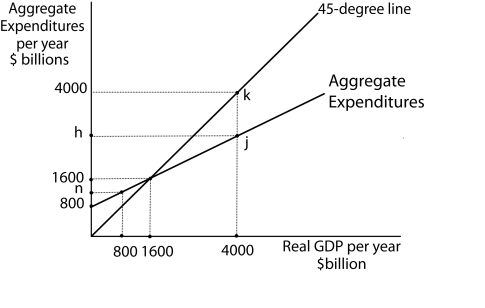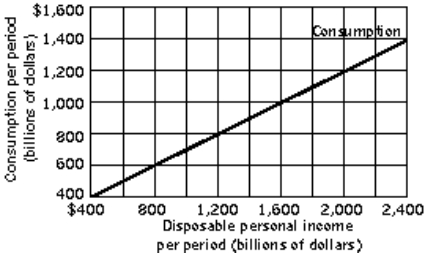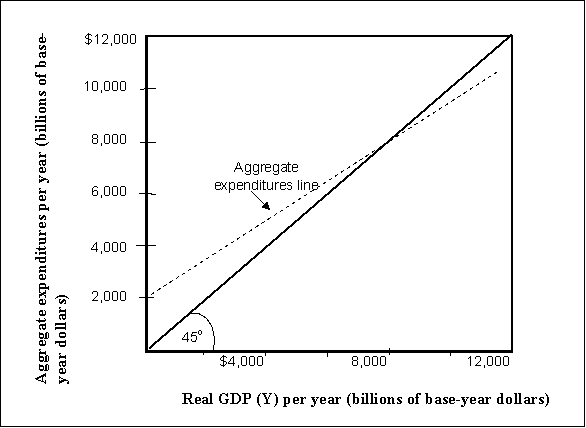A) income, consumption
B) investment, consumption
C) government spending, net exports
D) consumption, price
F) A) and C)
Correct Answer

verified
Correct Answer
verified
Multiple Choice
Let real GDP =Y = Yd, and the consumption function is C = $1,000 + .06Y. What is the value of autonomous consumption (A) and what is the marginal propensity to consume (MPC) ?
A) A = $600; MPC = 0.4
B) A = $1,000; MPC = 0.6
C) A = $1,600; MPC = 2.5
D) A = $2,500; MPC = 0.6
F) B) and C)
Correct Answer

verified
Correct Answer
verified
Multiple Choice
The aggregate demand traces
A) the total spending by consumers, business firms, and government agencies at a given price level.
B) the locus of equilibrium real GDP associated with each price level in the aggregate expenditures model.
C) the locus of equilibrium aggregate expenditures-real GDP combinations in the aggregate expenditures model.
D) the locus of equilibrium real GDP associated with each income level in the aggregate expenditures model.
F) B) and C)
Correct Answer

verified
Correct Answer
verified
Multiple Choice
Consider a simple economy that is made up of three sectors: households, firms, and government.Let Y = real GDP, AE = Aggregate Expenditures, C = Consumption, IP = Planned Investment, G = Government Purchases.Further, IP and G are autonomous. In this case, the slope of the aggregate expenditures curve is
A) 1.
B) infinity (since the AE curve is horizontal) .
C) equal to the marginal propensity to consume.
D) the value of the multiplier.
F) A) and D)
Correct Answer

verified
Correct Answer
verified
Multiple Choice
Unplanned investment occurs when I.aggregate expenditures exceed real GDP produced. II.aggregate expenditures fall short of real GDP produced. III.when real GDP produced is less than potential real GDP. IV.when real GDP produced is greater than potential real GDP.
A) I and II only
B) I and IV only
C) II and III only
D) I, II, III, and IV
F) B) and D)
Correct Answer

verified
Correct Answer
verified
Multiple Choice
Consider a simple aggregate expenditure model where all components of aggregate expenditure are autonomous except consumption.Which of the following causes the aggregate expenditures curve to shift downwards?
A) a decrease in taxes
B) an increase in imports
C) an increase in government spending
D) an increase in investment
F) B) and D)
Correct Answer

verified
Correct Answer
verified
Multiple Choice
Figure 13-6
 -Refer to Figure 13-6.What is the value of the multiplier?
-Refer to Figure 13-6.What is the value of the multiplier?
A) 1
B) 2
C) 3
D) 5
F) B) and D)
Correct Answer

verified
Correct Answer
verified
Multiple Choice
Figure 13-1
 -Refer to Figure 13-1.When disposable personal income is $2,000 billion,
-Refer to Figure 13-1.When disposable personal income is $2,000 billion,
A) personal saving is $1,200 billion.
B) consumption is $1,600 billion.
C) saving is $800 billion.
D) consumption is $800 billion.
F) All of the above
Correct Answer

verified
Correct Answer
verified
True/False
The multiplier effect is triggered by a shift in the aggregate expenditures curve.
B) False
Correct Answer

verified
Correct Answer
verified
Multiple Choice
Figure 13-6
 -Refer to Figure 13-6.Let Y = real GDP, AE = Aggregate Expenditures, C = Consumption,
IP = Planned Investment, G = Government Purchases.Further, IP and G are autonomous.
If real GDP produced is $4,000, how will equilibrium be restored in the economy?
-Refer to Figure 13-6.Let Y = real GDP, AE = Aggregate Expenditures, C = Consumption,
IP = Planned Investment, G = Government Purchases.Further, IP and G are autonomous.
If real GDP produced is $4,000, how will equilibrium be restored in the economy?
A) Policymakers must conduct contractionary policies to move the economy toward its equilibrium real GDP.
B) Firms will reduce their output in subsequent periods, moving the economy toward its equilibrium real GDP.
C) The price level must rise to reduce aggregate expenditures and restore equilibrium.
D) The price level must fall to increase aggregate expenditures and restore equilibrium.
F) A) and D)
Correct Answer

verified
Correct Answer
verified
Multiple Choice
In the aggregate expenditures model, if aggregate expenditures equal $800 billion and real GDP equals $600 billion,
A) unplanned inventory accumulation equals $200 billion.
B) unplanned inventory depletion equals $200 billion.
C) consumption plus investment equals $200 billion.
D) net investment equals $200 billion.
F) B) and C)
Correct Answer

verified
Correct Answer
verified
Multiple Choice
An upward shift in the consumption function can be caused by
A) expectations of product shortages.
B) expectations of less income in the future.
C) a decrease in consumer confidence.
D) a reduction in the wealth of households.
F) A) and C)
Correct Answer

verified
Correct Answer
verified
Multiple Choice
Suppose at each price level, autonomous aggregate expenditures fall by $80 billion.As a result, the aggregate expenditures curve shifts
A) downward at each price level and results in a leftward shift in aggregate demand.
B) upward at each price level and results in a rightward shift in aggregate demand.
C) downward at each price level and results in a movement down along a given aggregate demand.
D) upward at each price level and results in a movement up along a given aggregate demand.
F) B) and D)
Correct Answer

verified
Correct Answer
verified
Multiple Choice
In the aggregate expenditures model, in equilibrium,
A) aggregate expenditures equal real GDP produced.
B) inventory changes equal saving.
C) inventory changes equal investment.
D) aggregate expenditures equal consumption.
F) A) and C)
Correct Answer

verified
Correct Answer
verified
Multiple Choice
In the simple aggregate expenditure model where all components of aggregate expenditure are autonomous except consumption, what is the value of the multiplier if the marginal propensity to consume is 0.75?
A) 1
B) 4
C) 5
D) infinity
F) C) and D)
Correct Answer

verified
Correct Answer
verified
Multiple Choice
Figure 13-5
 -Refer to Figure 13-5.Let Y = real GDP, AE = Aggregate Expenditures, C = Consumption,
IP = Planned Investment.Consider a simple economy where AE = C + IP, IP is autonomous
And the consumption function is given by C = $1,000 billion + 0.75Y.What is the value of consumption when real GDP is $6,000 billion?
-Refer to Figure 13-5.Let Y = real GDP, AE = Aggregate Expenditures, C = Consumption,
IP = Planned Investment.Consider a simple economy where AE = C + IP, IP is autonomous
And the consumption function is given by C = $1,000 billion + 0.75Y.What is the value of consumption when real GDP is $6,000 billion?
A) $1,000 billion
B) $2,500 billion
C) $4,500 billion
D) $5,500 billion
F) C) and D)
Correct Answer

verified
Correct Answer
verified
Multiple Choice
Suppose that your annual income has averaged $20,000 for the past 10 years and that you expect it will average $20,000 over the next 10 years.If your income this year increases to $30,000 but your consumption expenditures don't change, then you are most likely acting according to the
A) transitory income theory of consumption.
B) current income hypothesis.
C) permanent income hypothesis.
D) disposable personal income theory of consumption.
F) B) and D)
Correct Answer

verified
Correct Answer
verified
Multiple Choice
Consider a simple aggregate expenditure model where all components of aggregate expenditure are autonomous except consumption.Which of the following causes the aggregate expenditures curve to shift upwards?
A) an increase in taxes
B) an increase in exports
C) a decrease in the national debt
D) a decrease in interest rate
F) B) and C)
Correct Answer

verified
Correct Answer
verified
Multiple Choice
Figure 13-6
 -Refer to Figure 13-6.Let Y = real GDP, AE = Aggregate Expenditures, C = Consumption,
IP = Planned Investment, G = Government Purchases.Further, IP and G are autonomous.If real GDP produced is $4,000, what is the amount of unplanned investment?
-Refer to Figure 13-6.Let Y = real GDP, AE = Aggregate Expenditures, C = Consumption,
IP = Planned Investment, G = Government Purchases.Further, IP and G are autonomous.If real GDP produced is $4,000, what is the amount of unplanned investment?
A) zero
B) $1,200 billion
C) $2,400 billion
D) $2,800 billion
F) All of the above
Correct Answer

verified
Correct Answer
verified
Showing 181 - 199 of 199
Related Exams